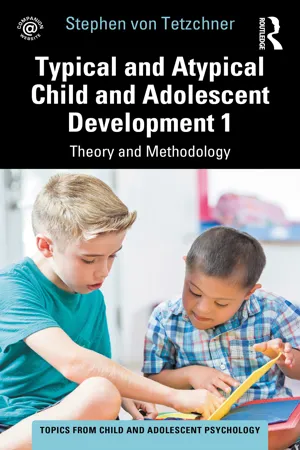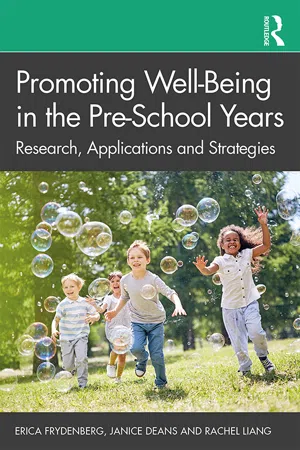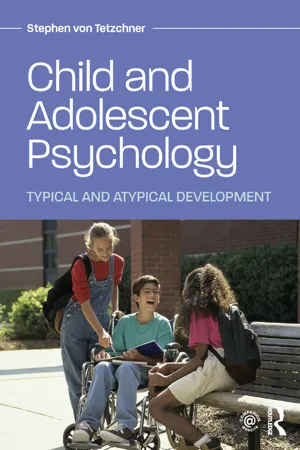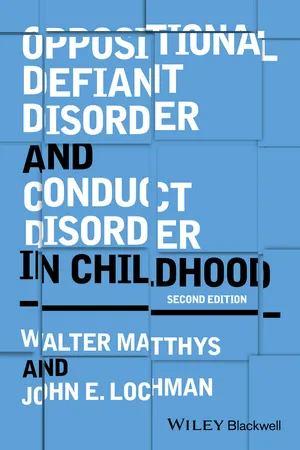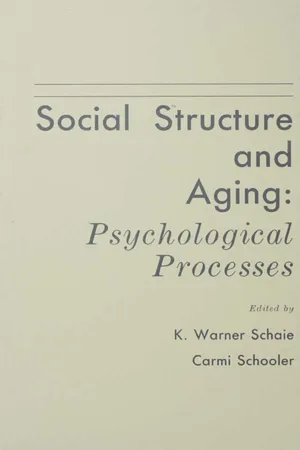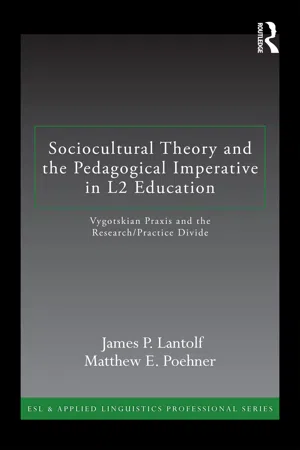Psychology
Environmental Factors in Development
Environmental factors in development refer to the external influences that impact an individual's growth and behavior. These factors can include family dynamics, socioeconomic status, cultural influences, and physical surroundings. Environmental factors play a significant role in shaping an individual's cognitive, emotional, and social development.
Written by Perlego with AI-assistance
Related key terms
10 Key excerpts on "Environmental Factors in Development"
- eBook - ePub
Understanding Psychology for Medicine and Nursing
Insights and Applications
- Mohamed Ahmed Abd El-Hay(Author)
- 2019(Publication Date)
- Routledge(Publisher)
Developmental milestones offer guidelines for the ages at which certain skills and abilities typically emerge, but concerns usually arise when a child falls slightly behind the norm. While developmental theories have historically focused upon deficits in behavior, focus on individual differences in development is becoming an important component of different psychological theories. Psychoanalytic theories are traditionally focused upon abnormal behavior, so developmental differences in these theories are described as a deficit in behavior. Learning theories rely more on the environment’s unique impact on an individual. Today, psychologists look at both norms and individual differences when describing child development.Factors Affecting Development and Growth
Development and growth are influenced by several factors including genetic and environmental factors. The following is a summary of possible factors that can affect development.Genetic Factors
A child is born with a unique set of genetic endowments that influence his or her physical growth. Genetics have a strong effect on rate of growth, the size of body parts, and the onset of growth events. Genes are a biological risk factor that cannot be changed. However, early interventions can improve the outcome of these risk factors on a child’s physical and cognitive growth and development. This is especially crucial when dealing with genetic conditions that are preventable, e.g., phenylketonuria (PKU), which is a recessive genetic disorder that leads to the inability to metabolize the amino acid phenylalanine, which accumulates to toxic levels, impairing brain development and leaving children mentally retarded, restless, and irritable. Although PKU is a hereditary condition, an early strict low-phenylalanine diet can prevent brain damage (Waisbren, Brown, de Sonneville, & Levy, 1994). A more detailed account of genetics was presented on pp. 106–109.Environmental Influences
The effect of environmental factors on development starts at conception. Malnutrition and intake of medications, tobacco, alcohol, recreational drugs or other chemical agents during pregnancy can affect the growth of a fetus either directly or indirectly. These substances can cause birth defects, and can also affect a child’s cognitive growth in the later developmental stages. The effect of these risk factors on a child’s learning and behavior may not become obvious for years. After birth, malnutrition, poor housing, pollution and lack of appropriate toys and activities may have detrimental effects on human growth. - Stephen von Tetzchner(Author)
- 2022(Publication Date)
- Routledge(Publisher)
Part IDevelopmental PsychologyPassage contains an image
1
Psychology and DevelopmentDOI: 10.4324/9781003291275-2Psychology is concerned with human beings’ (and animals’) under-standing of the physical and social environment, and the bases for their actions, feelings and experiences, as well as their participation in greater and smaller social networks and in society. Developmental psychology is concerned with how all this comes about, how children gradually change socially, mentally and behaviorally, the underlying processes and the factors that may influence these changes, for example how children’s understanding of the world and thinking changes over time, what makes children develop different abilities, how children form relationships with parents and peers, why boys and girls tend to play in different ways and come to have different interests and behavior, why some children are socially active and extrovert while others are more shy and careful, and how emotional expressivity differs between cultures. Developmental psychology also includes the developmental courses of children with sensory and physical disabilities, as well as the vulnerability and risk factors that underlie the emergence of learning disorders and emotional and behavioral disorders in childhood and adolescence, and factors that may prevent the development of such disorders.Development can be defined as an age-related process involving changes in the structure and functioning of human beings and animals as a result of interaction between biological structures, psychological states and ecological factors. While the organism adapts to its environment, the environment must also have properties that allow the organism to develop. At the core of the developmental process lies transformation: something new emerges, less becomes more, simplicity turns into complexity, limited skills evolve into advanced mastery (Overton, 2015). In all species, development toward adulthood implies a greater degree of autonomy- eBook - ePub
Promoting Well-Being in the Pre-School Years
Research, Applications and Strategies
- Erica Frydenberg, Janice Deans, Rachel Liang(Authors)
- 2019(Publication Date)
- Routledge(Publisher)
Chapter 2Development in context
‘Coping is finding ways of how your friends can help you be good again’ ~ Angel, 5- year-oldOverview
Human development is a dynamic and complex process impacted by genetic, epigenetic and environmental factors. Building on the earlier work of Lev Vygotsky (1962) and Jean Piaget (1952), Uri Bronfenbrenner’s (1979) socio-ecological perspective has been widely adopted and adapted since the 1970s to explain development in context. In the last two decades neuroscience or neurobiology along with epigenetics are continuing to advance our understanding of human capability and adaptation. This chapter provides an overview of the different theories in the contemporary context of early childhood development and well-being; from the age-old debate of nature versus nurture to how genes moderate environmental influences and vice versa.How nature and nurture interact
Development continues from conception to late adulthood. One of the oldest philosophical issues within psychology considers the relative contributions of genetic inheritance and environmental factors to human development. The unidimensional approach of nature versus nurture as being most significant developmentally has been replaced by the contemporary consensus that there is interplay between genetic predisposition and environmental opportunities. Whilst the relative contribution of each is still under discussion, it is important to acknowledge that both play a significant role in a child’s progression through life. Facets of development also act in tandem or interactively, but it is helpful to focus on each of the elements individually to best understand which significant aspects of development occur year by year. It is also important to note that children vary as to when they reach their developmental milestones in one aspect of their development and there may be asynchrony in how this occurs compared to another aspect of development. For example, a child may be advanced in language and cognitive development but may not have reached a similar milestone in social emotional development. Table 2.1 - eBook - ePub
Child and Adolescent Psychology
Typical and Atypical Development
- Stephen von Tetzchner(Author)
- 2018(Publication Date)
- Routledge(Publisher)
CHAPTER 1 DEVELOPMENTAL PSYCHOLOGY P sychology is concerned with human beings’ (and animals’) understanding of the physical and social environment, and the bases for their actions, feelings and experiences, as well as their participation in greater and smaller social networks and in society. Developmental psychology is concerned with how all this comes about, how children gradually change socially, mentally and behaviorally, the underlying processes, and the factors that may influence these changes, for example how children’s understanding of the world and thinking changes over time, what makes children develop different abilities, how children form relationships with parents and peers, why boys and girls tend to play in different ways and come to have different interests and behavior, why some children are socially active and extrovert while others are more shy and careful, and how emotional expressivity differs between cultures. Developmental psychology also includes the developmental courses of children with sensory and physical disabilities, as well as the vulnerability and risk factors that underlie the emergence of learning disorders and emotional and behavioral disorders in childhood and adolescence, and factors that may prevent the development of such disorders. Development can be defined as an age-related process involving changes in the structure and functioning of human beings and animals as a result of interaction between biological structures, psychological states and ecological factors. While the organism adapts to its environment, the environment must also have properties that allow the organism to develop. At the core of the developmental process lies transformation : something new emerges, less becomes more, simplicity turns into complexity, limited skills evolve into advanced mastery (Overton, 2015) - eBook - ePub
Psychological Criminology
An Integrative Approach
- Richard Wortley(Author)
- 2011(Publication Date)
- Willan(Publisher)
This chapter is informed by theories and research in developmental psychology. Developmental psychology is the study of the ways that humans both change and remain constant over time. Developmental psychologists study orderly changes and continuities in three interrelated domains: physical development, cognitive development and psychosocial development. A common misconception about developmental psychology is that it is child psychology. While a great deal of attention in developmental psychology is indeed given to the critical early years of childhood, development continues across the lifespan: from ‘womb to tomb’. Many theorists argue that an individual’s future is not set in concrete by their childhood experiences. Instead, throughout each period of life there are critical transition points that may lead an individual down one pathway or another. The chapter begins by setting out the biological and environmental foundations of development. There follows a review of the critical developmental factors that increase or reduce the risk that an individual will engage in crime. Development in three specific psychological domains particularly relevant to criminology – attachment, moral reasoning and self-control – is then discussed. Finally, the criminal careers perspective is presented, with an examination of variations in offending patterns across the lifespan.The Biological and Environmental Foundations of Human DevelopmentThe focus of this section is on how genes and the environment combine to shape the process of development. The key point to be made is that biosocial processes produce a wide array of developmental possibilities that help account for individual differences in offending patterns. The first task in this analysis is to identify the sources of influence on development.Heritability Revisited: Shared and Non-Shared EnvironmentsAs discussed in Chapter 3 , heritability studies estimate the portion of the variance in a trait that is attributable to genetic factors on the one hand, and environmental factors on the other. These studies have revealed that in general .3–.5 of trait variance is attributable to genetic factors, leaving .5–.7 due to environmental factors. However, in most modern heritability studies, environmental factors are further broken down into shared (or common) environments and non-shared (unique) environments (Plomin et al - Walter Matthys, John E. Lochman(Authors)
- 2016(Publication Date)
- Wiley-Blackwell(Publisher)
Among various psychopathological disorders, conduct problems have been shown to be influenced in unusually substantial ways by the social context around the child, and the manifestations of the conduct problems directly affect persons in their social context (Jimmerson, Espelage, & Swearer, 2010; Moffitt & Scott, 2008; Morcillo et al., 2015). Develop–mental models of children’s conduct problems have been heavily influenced by ecological theories of child development (Bronfenbrenner, 1995) which have suggested that children’s behavior is the result of individual characteristics (such as irritable temperament) and of social and contextual influences that radiate out around the child (Lochman, Barry, & Salekin, 2005; Lochman & Gresham, 2008). Social contexts that are most proximal (Microsystems) are those in which the child spends the most time and which are likely to have the most impact on the child’s behavior, Prominent proximal social contexts include the family environment (McDonald, Baden, & Lochman, 2013; Pepler, Jiang, Craig, & Connolly, 2008), the school environment (Barboza et al., 2009; Thomas, Bierman, Powers, & Conduct Problems Prevention Research Group, 2011), and peer groups (Barth et al., 2013; Cook, Williams, Guerra, Kim, & Sadek, 2010; Powers, Bierman, & Conduct Problems Prevention Research Group, 2013). Children’s broader environments (Exosystem), such as their neighborhoods, and the medical clinics, social agencies, and recreation centers within their communities, also can impact the children but often in an indirect way (Barry, Lochman, Fite, Wells, & Colder, 2012; Fite et al., 2010). Typically this occurs, because the stresses produced by these community and family forces leads to disruptions in the parents’ efforts to raise and discipline their children. The ecological model also stresses the importance of understanding how these systems interact with each other (Mesosystem) and how these interactions between systems also influence the children’s behavioral development. For example, parents’ abilities to interact in positive, proactive ways with school personnel (crossing the family and school systems) can assist children’s positive behavior.As children develop, they can experience an accumulating and “stacking” of risk factors within their ecology¸ increasing the probability of the children eventually displaying serious antisocial behavior (Loeber, 1990). These risk factors can be conceptualized as falling within multiple categories: biological and temperamental child factors, family context, neighborhood context, peer context, and later emerging child factors involving their social–cognitive processes and emotional regulation (Lochman, 2004). In this chapter’s review of environmental risk factors that are related to children’s conduct problems, risk factors that are biologically related will be noted first, followed by contextual factors in the family, neighborhood and peer group, and, finally, by a discussion of their impact on children’s developing social–cognitive and emotional regulation processes. The effects of some of these risk factors are due to their association with other environmental (such as poverty) or genetic risk factors.- eBook - ePub
Introducing Bronfenbrenner
A Guide for Practitioners and Students in Early Years Education
- Nóirín Hayes, Leah O'Toole, Ann Marie Halpenny(Authors)
- 2022(Publication Date)
- Routledge(Publisher)
4 Understanding development in contextDOI: 10.4324/9781003247760-4Introduction
The bioecological model acknowledges that children do not develop in isolation; rather, development is embedded within and across many contexts such as family, home, school, community, society and culture. Young children learn and develop in the midst of society, and the ordinary spaces, places and people they come in contact with have a profound influence on them (Hayes, 2013 ; O’Toole, Hayes, & Halpenny, 2020 ). Each of these ever-changing and multilevel settings influences, either directly or indirectly, the pattern of child development and learning. Such contexts extend beyond the child’s immediate environment (e.g. home and early childhood setting) to encompass the broader sociocultural contexts in which development is embedded.Building on the concepts outlined and discussed in the previous chapters, we now explore the contexts that inform and guide children’s learning and development. Ultimately, all the contextual factors influencing a child operate through the child’s immediate environment – the people, places and things with which the child has direct contact. However, the values of a particular culture are also reflected in the structure of the settings in which children spend their time. This chapter further explores how the bioecological model can offer a framework to incorporate many sociocultural insights on understanding development in context. In particular, we interrogate the idea of ‘internalisation’, or the incorporation of contexts for development into the personal characteristics of the developing child.Bronfenbrenner’s theory highlights the importance of actively linking early years settings to other important environments in the lives of young children as well as understanding the rich “funds of knowledge” (Hedges, 2014 ; Wood, 2013 ) children bring with them from the various contexts in which they are developing. Increasingly, the number and range of contexts young children traverse on a day-to-day basis are expanding, creating a potential for ‘culture shock’ where these are very different (O’Toole et al., 2020 ; O’Toole & Hayes, 2020 ). When the culture of the home and that of the early years setting are different, it may be difficult for children to adjust (Brooker, 2015 ), and this is explored in detail in Chapters 5 and 10 - eBook - ePub
The Language of Winnicott
A Dictionary of Winnicott's Use of Words
- Jan Abram(Author)
- 2018(Publication Date)
- Routledge(Publisher)
Environment1 The impact of the environment on human development 2 The analytic setting—a holding environment 3 Psychosis—an environmental deficiency disease 4 Psychotic anxiety 5 Impingement 6 Fear of breakdown 7 “We are poor indeed if we are only sane” 8 Father—the indestructible environment Winnicott’s theory of emotional development lays an emphasis on the psychic environment and its responsibility for the emotional health of the infant.The first environment for the infant is mother, and at the beginning they are merged together in an environment–individual set-up.The emotional environment cannot be held totally responsible for what becomes of the infant in terms of his mental health; it can only provide a spectrum of available experience: at the good end it is facilitating, at the other it is damaging.The facilitating environment enables the individual to take the opportunity to grow and will usually lead to health, whereas the emotional environment that fails, particularly in the beginning, is more likely to lead to mental instability and ill health.1 The impact of the environment on human developmentPsychoanalytic literature makes reference to the mother’s role in relation to her infant, but, in the main, until around 1950, the theoretical thrust had been very much on the individual and his inner world. The impact of the environment on the mental health of the individual had not really been accorded the importance it has since held in analytic theory, and Winnicott’s contribution is seminal.In 1942, Winnicott found himself jumping up in a meeting and saying, “There’s no such thing as a baby!” It was, for him, a moment of true discovery, which he relates ten years later, in his paper, “Anxiety Associated with Insecurity”, presented to the British Psycho-Analytical Society in 1952. The individual was from then on no longer a unit, but an environment–individual set-up—the nursing couple.. . . if you show me a baby you certainly show me also someone caring for the baby, or at least a pram with someone’s eyes and ears glued to it. One sees a nursing couple . . . before object relationships the state of affairs is this: that the unit is not the individual, the unit is the environment–individual set-up. The centre of gravity of the being does not start off in the individual. It is in the total set-up. - eBook - ePub
Social Structure and Aging
Psychological Processes
- K. Warner Schaie, Carmi Schooler, K. Warner Schaie, Carmi Schooler(Authors)
- 2013(Publication Date)
- Psychology Press(Publisher)
Population Studies Perspective is a broader area of inquiry that brings the contributions of a wide variety of disciplines to bear on our understanding of the demographic factors (Hauser & Duncan, 1959). The population studies perspective emphasizes that demographic factors are best understood in a context that includes the social, political, and economic evolution of the society whose population we are investigating. This chapter is based entirely on the situation in the United States, and I have serious reservations about the extent to which any of my ideas apply to other cultures.The adult development perspective concerns the psychological evolution of the individual from the time he or she reaches the socially defined beginning of adulthood to the end of the human life span. As used here, the word development implies neither contraction nor expansion but merely the cumulative response to one’s life history. Individual development involves the acquisition and accumulation of ideas, which we often differentiate into knowledge, attitudes, values, beliefs and ideologies, and psychological skills, to which we apply labels such as intelligence, learning, memory, creativity, thinking, problem solving, and coping. Further, the developmental perspective looks at the mind and its various dimensions as an evolving whole. This evolutionary perspective is useful for us to gain insights into the effects of aging on the interaction between the individual’s mental processes, subjective experiences, and adaptive strategies on the one hand and his or her social environment on the other (Atchley, 1983).Demographic effects on adult development can be both direct and indirect. For example, the size of one’s birth cohort directly influences the social context within which adult development takes place. Because peer groups are age graded and limited to a size that will allow face-to-face communication, as the size of an age cohort increases the larger the number of peer groups to be found within it, the greater the diversity of behavioral norms across peer groups, and the lower the sense of identity with the entire cohort (Mott, 1965). All these factors can influence which skills are reinforced and which are not. On the other hand, cohort size indirectly influences occupational development through its effect on the amount of competition within an occupational area. The degree of job competition in turn may influence the priorities given to various developmental issues. This topic needs further research. - eBook - ePub
Sociocultural Theory and the Pedagogical Imperative in L2 Education
Vygotskian Praxis and the Research/Practice Divide
- James P. Lantolf, Matthew E. Poehner(Authors)
- 2014(Publication Date)
- Routledge(Publisher)
Chapter 2 , created by human activity over the course of history. By creating and changing the world, and not merely adapting to it, as proposed in Piagetian psychology, humans change not just the social circumstances in which they live, but these very circumstances shape their psychology. However, Vygotsky (1994b, p. 338) cautioned that socio-cultural psychology is not interested in the “study of the environment as such,” but in its “role, meaning and influence” in development. In other words, what matters is the relationship between individuals and their environment, and this relationship changes not only as the environment changes but as the individual emerges as a psychological being over the course of ontogenesis.Consider the case of a newborn infant. The only aspects of the world that matter as far as the infant is concerned are the phenomena most immediately surrounding her and in some way connect to her body. As the child grows, however, features of the environment that did not matter at the outset are brought into contact with the child and in this sense begin to exist for the child and to influence her development. Vygotsky (1994b, p. 339) pointed out for example that although the language surrounding children at 6 months is the same as when they are 18 months or even 3 years old it assumes a different meaning for them as their comprehension improves.Illustrating the Role of the Environment
Vygotsky (1994b) provided a concrete example of child–environment interaction when he recounted the case of three children from the same family brought to his clinic for observation and treatment. He pointed out that the objective circumstances within the family were the same for the three children. Their mother was an alcoholic, who also suffered from other psychoses (p. 340). When inebriated she frequently beat the children and on one occasion even attempted to throw one of them out of a window. Vygotsky determined that each child presented “a completely different picture of disrupted development, caused by the same situation” (p. 340). The youngest child developed neurotic tendencies that resulted in episodes of feelings of helplessness and “incomprehensible horror” (p. 341). At times he was unable to speak and suffered from depression. The second child experienced the situation as a conflict between simultaneous strong attachment and feelings of hatred, fear, and hostility (p. 341). The oldest child oriented to the situation as a family misfortune that required him to take on the responsibility “to mitigate the misfortune and to help both the sick mother and the [other] children” (p. 341). Vygotsky concluded that the same set of circumstances influenced the children’s psychological development in different ways. In other words, the source of development existed in the environment but its effect on development was experienced differentially by the three children. Changing the circumstances by helping the mother overcome her alcohol abuse or by removing her from the life of the children would also be expected to have differential effects on the psychological development of each of them.
Index pages curate the most relevant extracts from our library of academic textbooks. They’ve been created using an in-house natural language model (NLM), each adding context and meaning to key research topics.

